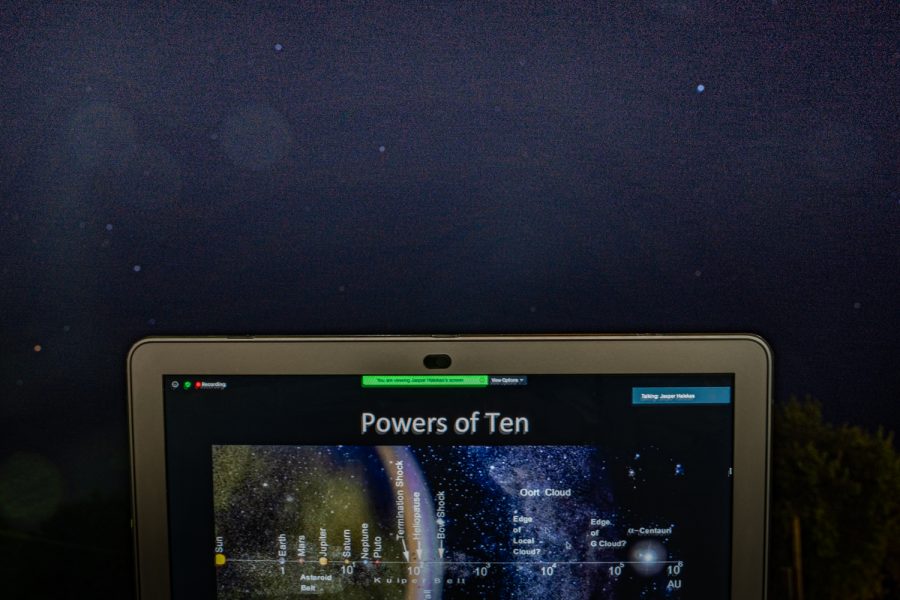University of Iowa Physics and Astronomy department hosts first-ever virtual astronomy, observation night
The department’s “Hawk-Eyes in Space” outreach program moved its annual observation nights online to prevent further spread of COVID-19.
The University of Iowa Physics and Astronomy Hawk-Eyes in Space outreach program hosts a public observing night on Zoom on Friday, June 12, 2020. The group is hosting a series of public nights, each with different astronomical emphases.
June 14, 2020
For the first time ever, the University of Iowa Physics and Astronomy department’s “Hawk-Eyes in Space” outreach program hosted a virtual observation night in lieu of its traditional in-person format. The four-part series kicked off with its first online event June 13.
Caroline Roberts, the manager of Van Allen Observatories and UI astronomy laboratory coordinator, said the event shifted to a virtual format amid concern over COVID-19. The observation nights are typically hosted on the UI Pentacrest or from the Van Allen Observatory.
Roberts said the event differed from previous observation nights beyond just the virtual format. Presentations were given this time by both faculty and undergraduate students, she said.
“That’s certainly a little bit new and foreign,” Roberts said. “But after half a semester online, all of the faculty members and undergraduate students feel pretty confident.”
Jasper Halekas, UI Physics and Astronomy associate professor, presented on solar wind. Halekas is part of a UI-led research mission to develop Tandem Reconnection and Cusp Electrodynamics Reconnaissance Satellites — a pair of orbiters to study the origins of the solar wind and how it affects Earth.
The research team won a $115 million research award from NASA in 2019 — the largest research grant the UI has ever received.
RELATED: UI physicists receive $1 million grant from NASA
The virtual format worked for the observation night, Halekas said, but there were obstacles for the presenters.
“You can’t get the same kind of non-verbal feedback from the audience that you would in an in-person format,” Halekas said.
Halekas said the difficulties with an online observation and presentation night are similar to the challenges of virtual instruction for college courses.
“I also think it’s much harder for students to focus and keep up with the discussion in a virtual format,” Halekas said. “So, I really hope we’ll be able to return to in-person instruction as soon as it is safe to do so for everyone.”
Roberts said about 70 people attended the observation night virtually — which is similar to the average attendance for past events in-person.
In previous years, attendees could observe space through a telescope on the UI Pentacrest or the Van Allen Observatory. This event instead included live-streamed visuals from the Iowa Robots Observatory stationed in Arizona.
The UI telescope, called Gemini, belongs to UI robotics students who are using it for research in the summer season.
“A condition of us using it is that we correspond with those students and just make sure our observing during this time is not going to interrupt their work,” Roberts said.
Roberts said the student and faculty presentations were added to the event to provide additional content in case there were issues with the telescope.
“Partly because the format was so new, I just wanted to make sure that we had, perhaps you could say, a backup in case there’s technology issues,” Roberts said.
Roberts said the events are like a mini astronomy course. Each night in the series will have a unique theme and the presentations will focus on that topic. The theme on June 13 focused on the solar system.
Cole Dorman, UI undergraduate student and president of the Society of Physics Students Organization, presented first with an overview of the bodies in the solar system.
“There’s no better way to start off the solar system than with the sun,” Dorman said.
To encourage audience participation, Dorman’s presentation featured an interactive poll where attendees could vote on their favorite planet — ultimately, Earth and Jupiter tied.
Presenters also took advantage of the chat feature in Zoom so audience members could ask Dorman and Halekas questions during their presentations. Dorman said he really enjoyed interacting with all of the participants.
Roberts said the program is unable to host similar virtual observation nights after the events in June because the Arizona observatory will close soon for the monsoon season.
“We’re going to have to do some more creative brainstorming to figure out how we’re going to convert that experience to a virtual format,” Roberts said.














